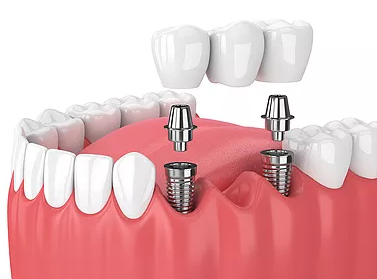DENTAL IMPLANTS
Dental implants are a secure, more permanent option for replacing missing teeth than bridges or dentures. Read more about the full implantation process here, but in a nutshell, an implant involves fixing a titanium screw to your jawbone to which we’ll attach a small post.
Then we’ll fix a dental crown or denture onto the post, making your implant as secure - if not more so - than a normal tooth. And because we’ll match the implant to your other teeth, no one will be able to tell the difference.

Single Tooth Gap
A single tooth gap can easily be filled with an implant, and may be suitable in cases such as:
- Tooth extracted due to trauma, infection, failed root filling and/or root fracture
- Crowns keeps falling out and/or not enough tooth left to attach crown
- Repeated infections
- Permanent tooth missing from birth
An implant-supported single crown looks and functions just like a natural tooth.
There's no need to damage adjacent healthy teeth, and continued use (loading) prevent resorption shrinkage of the underlying bone.
The implant-supported tooth also prevents lateral movement (drifting) of adjacent teeth and over-eruption of opposite tooth
Crowns have a very high and predictable long-term success (98 percent) with conventional oral hygiene dental care.
Alternatives to a crown:
Leave a gap
- Unsightly
- May impair eating, speech, confidence
- Bone and gum in the gap will skink
- Positions of adjacent opposing teeth will be distorted over time
Conventional bridge
- Healthy adjacent teeth need to be damaged to attach/support the bridge, thus compromising their long term health
- Bone supporting the gum beneath will shrink due to lack if use
- Extra stress on supporting teeth during chewing

Multiple Tooth Gap
Multiple teeth implants are more complicated, but we’re more than up to the challenge! Usually, the fitting of multiple implants will be a two-stage process- initially, the implant is installed and covered by gum, then an abutment is attached at a later date.
Usually, a temporary tooth is put in place, followed by a 3-6 month healing period, before the final installation. However, the procedure rarely causes patients discomfort.
Implants are the best solution for those with multiple missing teeth, particularly in the back of the mouth, where a dental implants will provide stability and the ability to eat whatever you want.
Problems caused by multiple gaps:
-
- More than one tooth missing
- Poorly fitting partial denture or a failing tooth-supported bridge
- Unable to chew properly and eat what you want
- Food gets stuck under your denture leading to embarrassment or discomfort whilst eating
- Loose teeth or not enough teeth to support a bridge
Implants as a solution:
-
- Permanently fixed bridge supported by implants
- Eat anything you choose
- Looks and works just like natural teeth
- Fixed in place, no need to remove it to clean
- No need to damage adjacent healthy teeth
- Should last a lifetime with good oral hygiene and professional maintenance
- Prevent shrinkage of underlying bone

